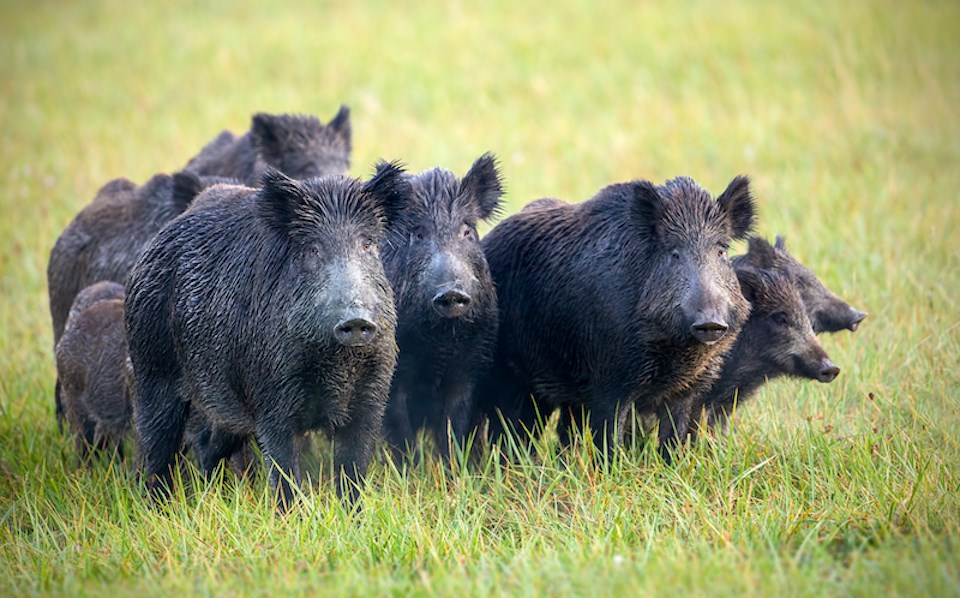Feral pigs might look like a far cry from domesticated swine but the two are more closely related than you think.
Wild pigs have been spreading across swaths of North America for years and populations have been established in the Canadian Prairies in Saskatchewan, Manitoba, and Alberta.
British Columbia's isn't as extreme as the ones further east but the province has identified the animal as "high risk" with "significant potential to spread."
Feral swine spread rapidly, producing two litters with up to 10 to 12 piglets annually. And they don't have trouble navigating harsh Canadian winters — they were built for them.
Invasive Species Council of BC executive director Gail Wallin tells V.I.A. the Canadian government incentivized farmers in the 1970s to breed their pigs with imported wild boar to create hardier animals.
But the escapees — domestic pigs that leave farms and properties — are tremendously resilient.
Established wild boars are easily identified by their small tusks, darker colour, and hairy coats. However, not all wild pigs appear wild, and, according to the B.C. government, any pig not on private property is considered a wild or invasive animal.
"If your pig is not contained, it is considered a feral pig," Wallin emphasizes, adding that people should ensure their swine are properly contained.
Pigs are intelligent and agile creatures that hop out of enclosures or dig out under fences. They root around the soil with their snouts to find food and can easily dig under barriers.
This "rooting" behaviour makes them environmentally problematic because they damage ecosystems. They often live close to water and create mud "wallows" by rooting in the shallows.
Once it has escaped, a domestic pig may breed with a wild one or another domestic one and create a "sounder" — a herd of feral pigs or boars.
What does a wild pig look like and how do they survive?
Wallin notes that the pig's offspring may evolve rapidly through generations. While the initial escapees may look domestic, the third or fourth generations may more closely resemble boars.
While they aren't small animals, they aren't always easily spotted. The government isn't aware of how many exist in B.C. but they have been spotted in the Lower Mainland, Â鶹´«Ã½Ó³»Island, Thompson-Okanagan, Peace, Chilcotin and Kootenay regions.
The government is worried about pigs spreading in places struck by wildfires because they flee when fences burn down, explains Wallin.
Licensed B.C. hunters may hunt wild swine in areas where it is legal to do so — but this practice may harm efforts to quell emerging populations.
Sounders may split into factions when one of their members is killed or injured, making it more difficult to locate the others. This instinct is observed in many animals, including Pharoah ants, another invasive species that goes into "reproductive overdrive" when it senses a threat. These pint-sized pests wreak havoc on Metro Â鶹´«Ã½Ó³»buildings by splitting the colony into groups that spread from apartment to apartment.
The Canadian government has also identified feral pigs as posing a risk of (ASF). No cases have been reported in Canada but it would have profound implications on the economy if cases were identified in wild or domestic swine.
Canada is the world's third largest pork producer and the pork industry generates $24 billion from direct and indirect jobs and exports. If a case of the virus is identified, it will slow the industry to a grinding halt.
Wild pigs are also more aggressive and territorial than domestic ones, posing a risk to humans and other animals.
Do you have a pet pig in Metro Vancouver?
While feral hogs aren't typically a city issue, the government has received reports of pot-bellied pigs on the loose.
People may buy small pigs weighing 20 to 40 pounds without realizing they might grow significantly larger. Some breeders sell animals under the pot-belly moniker that refers to several species.
"They can get up to 150 pounds," Wallin says, noting that people may release them into the wild when they reach an unmanageable size. They also live up to 15 years and many owners aren't prepared for the commitment.
Feral rabbits have overtaken the park around Jericho Beach and areas across the Lower Mainland. While fewer people own pigs, it wouldn't be difficult for a pair of hardy pot-bellied pigs to live in the mild climate.
The Canadian Council on Invasive Species has a "" campaign to spread the word about feral pigs and to report sightings.
To prevent the spread of feral pigs, do not release any into the wild. Report any sightings of them on the Report Invasives mobile apps. The apps can be used offline as well. You can complete the report when you are at the invasive species location, click 'Submit' and the report will be sent as soon as you are back in cell coverage.
If you do not have a smartphone, you may report using the or via email to [email protected] (attach your photo to the email).




